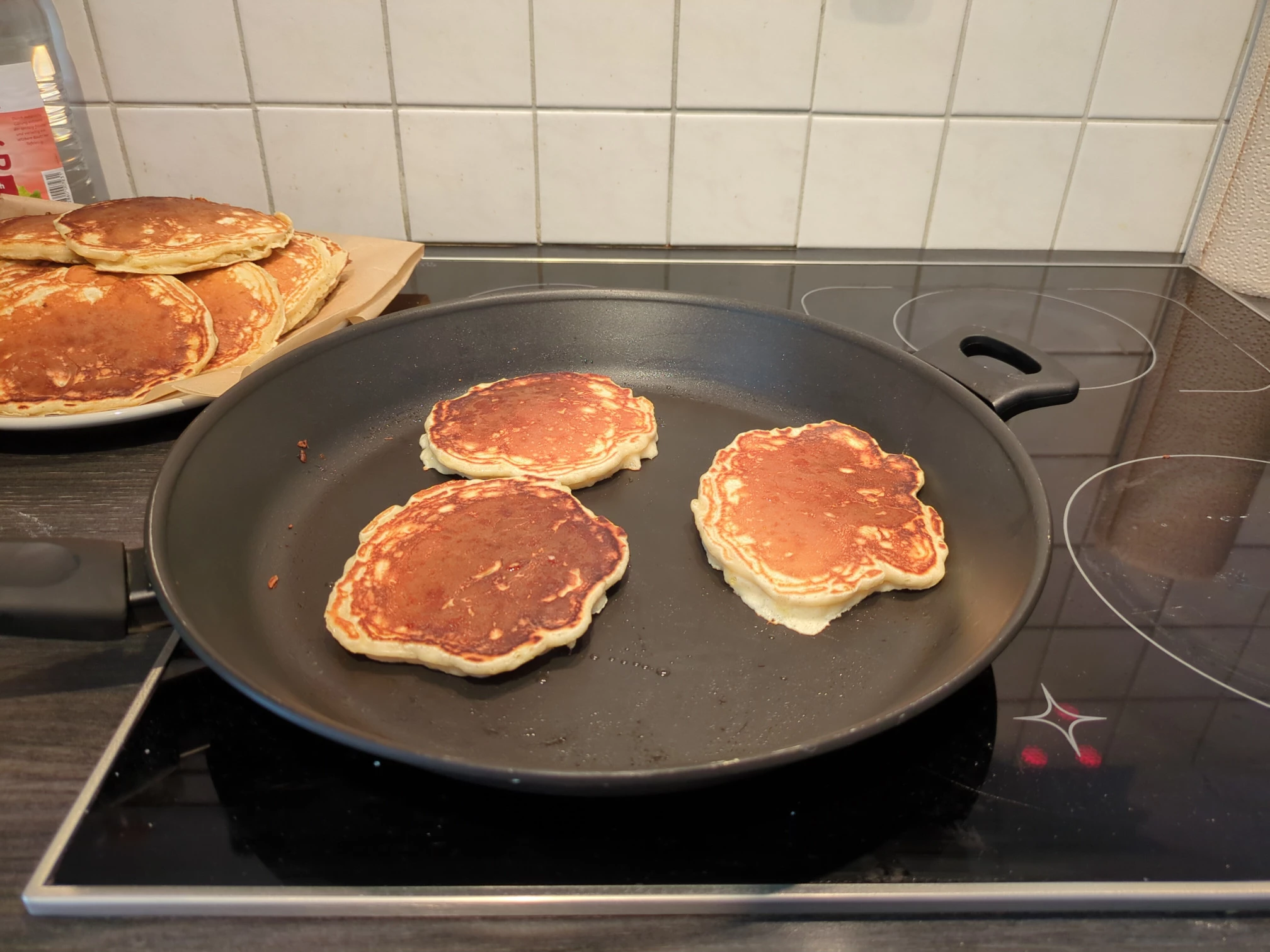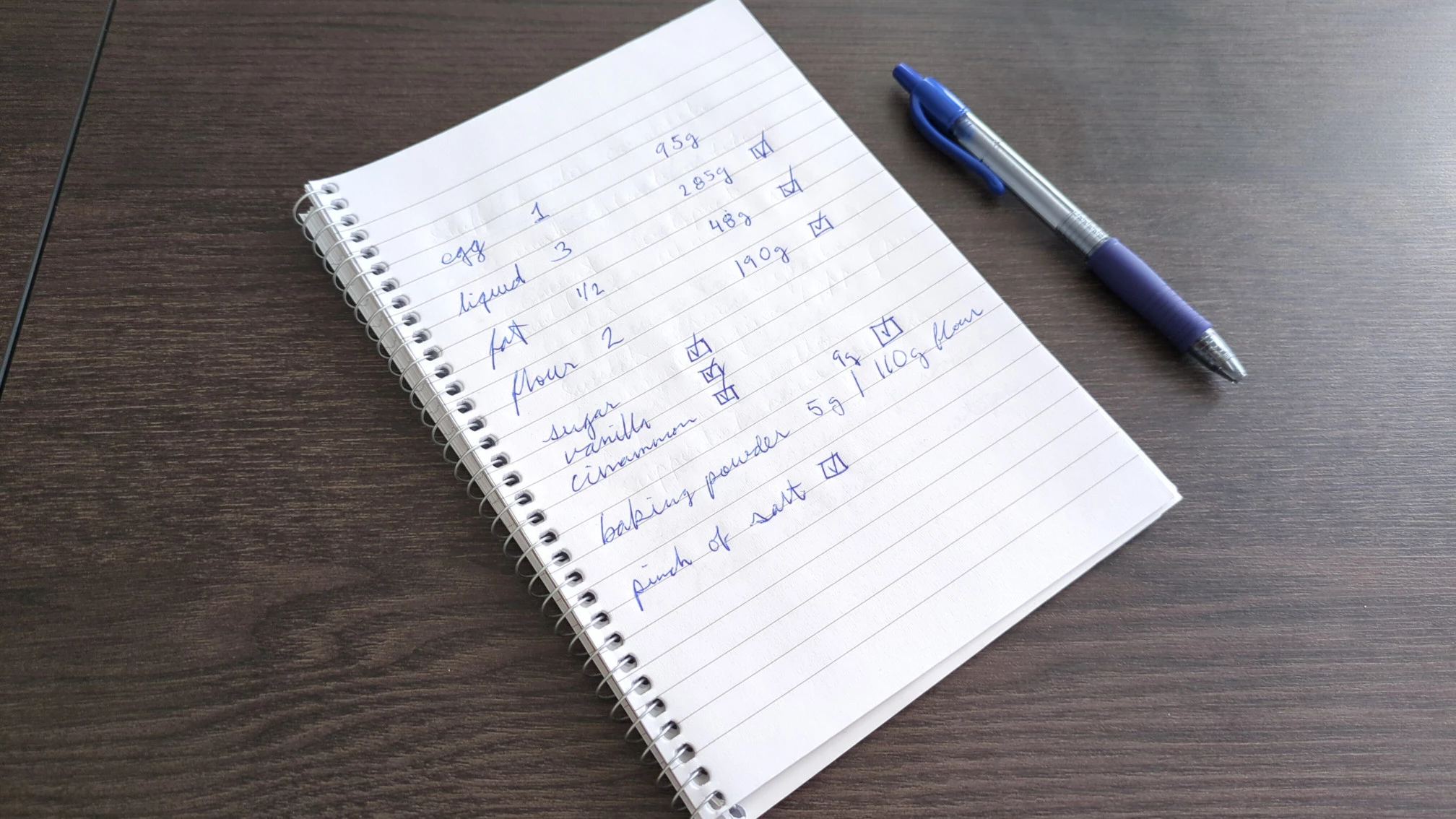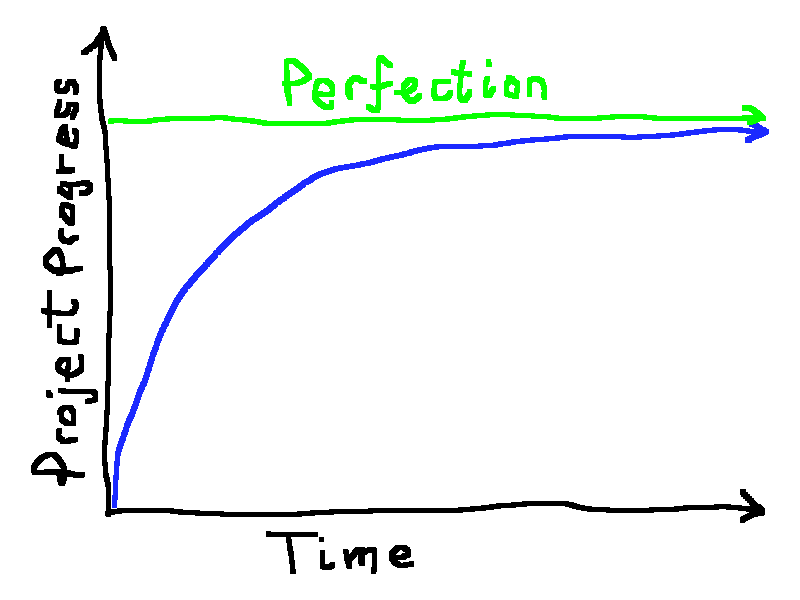Pancake/Waffle Calculator
Web DevelopmentDetailed Instructions
First, tap (or click) on the ingredients in the first column, if you want to change them. You don't have to use exactly what's in each of those lists. What's important is that you have the following:
- Egg or egg substitute
- Liquid
- Fat
- Flour
And yes, you can technically use water for pancakes. They wouldn't taste as good, but if you're in a pancake emergency it'll do.
If you have cake flour, I recommend using that over All Purpose (AP) flour. It's milled finer, has a lower protein content, and it'll really put the cake into pancake.
Kitchen Scale
You need a kitchen scale. As you may have noticed, all the measurements are in grams (g). It's just the best and most accurate way to measure things out.
Measuring cups are terrible. They're not as accurate as a scale, and you have to clean them afterwards which doubles the amount of dishes to clean. Plus I can never easily pour flour into them without getting flour everywhere. And yes when you measure flour in a cup you have to pour it in, otherwise you'll compact the flour and put the wrong amount into your recipe.
So just get a kitchen scale, they're like $10 for a cheap one.
Wet Bowl Dry Bowl Method
It's exactly as it sounds. You put the dry ingredients in the dry bowl, and you put the wet ingredients in the wet bowl.
Once you have everything measured out and mixed together uniformly in their separate bowls, pour the wet ingredients into the dry ingredients and mix them together with a spoon. Do not over mix the ingredients. It's okay to have small lumps of flour in the mix, those help create air pockets in the pancakes as they cook.
Hot Tip: You can put the sugar and salt in the wet bowl. They will become wet ingredients as they dissolve, and they will be distributed more evenly.
Measuring Your Ingredients
It's pretty simple. Place your wet bowl on the scale, and press the tare button (or zero it out however way your scale works). Then crack your eggs into the bowl. I do about one egg per person, maybe throw in an extra if you have a lot of very hungry people.
If you are going to be cracking a lot of eggs, you should crack the eggs into a separate bowl first then add the egg into the main bowl. That way if you have a spoiled egg by chance, you won't ruin the rest.
Once you have your eggs measured, take that egg measurement, and type that into the first quantity box at the top. The boxes below will populate with the necessary amount. Then you can measure the wet ingredients in the wet bowl, and the dry ingredients into the dry bowl.
But hey Tom! There are no measurements for sugar, salt, cinnamon, or vanilla!
-You (ignorant)
Those are up to your personal preference. To give you an idea, I do a big spoonful (regular eating sized spoon, from the drawer) of sugar per egg. But you can add less sugar in if you're watching your sugar intake, or more if you have a sweet tooth. Start out with one per if you're unsure though.
For the salt just do a pinch for like every two or three eggs. And I mean literally take your thumb and index finger, pitch a small amount of salt from a salt jar, and throw it in. This isn't super important, but this small pinch of salt can add some contrast to the sweetness, therefore enhancing it. Same concept as salted caramel.
And for the cinnamon and vanilla, just eyeball it. You can even skip these if you don't have them. I personally really like these in my pancakes.
And finally for the last of the ingredients, just add what you want! You can add blueberries, chocolate chips, pecans, whatever you want! They're your pancakes to ruin :-)
Help! The batter is too thick!
Don't panic! If the batter is too thick and it looks more like a bread dough than a runny pancake batter, just stir in a little more milk until it has the consistency that you desire.
Making Pancakes

Making pancakes is pretty simple. I recommend using a thick pan or griddle, something made from cast iron, that way the heat is more consistent. But it doesn't really matter, you can use a non stick pan or whatever you have available in the kitchen.
Heat your pan up on medium-high heat, and spritz a very small amount of cooking spray on to the pan. If you don't have cooking spray, you can pour a couple drops of neutral oil onto your pan and spread it around with a paper towel. Adding a little cooking oil is more important for cast iron and stainless steel pans, but it doesn't matter as much for non stick pans. You probably can get away with using no oil in a non stick pan.
You'll want to cook your pancakes until they're a nice brown on each side. If you're not sure if the pancake is ready to be flipped, you can gently slide your spatula a little under the pancake, and lift it up slightly to check whether it's brown enough.
My pancakes look weird!
I think everyone who's made pancakes knows these weirdo freak pancakes that come out when we try to make the very first pancakes in the pan. I've found that there are two main things that cause this:
- Too much oil in the pan
- The pan is not hot enough
When you have too much oil in the pan, it can mess up the look and taste of your pancakes. The pancakes with get a really weird look on them as they shallow fry in the oil, and they can absorb the oil and make them taste greasy. You should have very little in the pan, if any at all. We're making pancakes after all, not funnel cakes.
When the pan isn't hot enough, the pancake will cook unevenly and have splotches of brown and usually a brown ring around it. The solution is to just let your pan get hot. If you're unsure if your pan is hot enough or not, you can just make a single test pancake and see, instead of going all in and potentially making several subpar pancakes. They should still taste okay, but they won't have that nice restaurant look.
Making Waffles
Making waffles is extremely simple, much simpler than pancakes. But I recommend reading your waffle maker's manual, as every waffle maker is different. The main steps are:
- Spritz oil on the inside of the waffle maker (or rub oil on with a paper towel)
-
Pour the batter into the waffle maker and close it
- Cook to the desired brownness
The hardest part about making waffles isn't cooking them, it's cleaning the damn waffle maker afterwards.
The Ingredient Ratio
You're probably wondering how the ingredient measurements are calculated. The ingredients are calculated based on a pancake ratio from the book Ratio: The Simple Codes Behind the Craft of Everyday Cooking, by Michael Ruhlman. And the ratio is as follows:
| Egg | Flour | Liquid (Milk) | Fat (Butter) |
| 1 part | 2 parts | 2 parts | ½ part |
So for every egg you add to your recipe, you add 2 parts flour, 2 parts liquid, and a half part fat by weight.
And the amount of baking powder comes from the same book, which is: 5 grams for every 110 grams of flour. But I'm basing my entire recipe on the weight of the eggs, so I figured out what I need to multiply the weight of the egg by in order to get the amount of baking powder like so:
And with that, as you can see, I get the ratio 1 part baking powder for every 11 parts egg. Or just multiply by one eleventh.
What about the waffles?
This is the interesting part. It was pretty annoying trying to find a ratio for pancakes. Most recipes on the internet and in books tell you a very specific recipe with a specific amount of eggs and a set amount of weights or volumes for the other ingredients. But eventually I did find a ratio for pancakes as you saw above. But I could not find a single ratio for waffles. I looked high and low digitally. So what I ended up doing was collecting many waffle recipes that were written out by weight, and averaging them out. So here's the waffle ratio I calculated and rounded.
| Egg | Flour | Liquid (Milk) | Fat (Butter) |
|---|---|---|---|
| 1 part | 2 parts | 3 parts | ½ part |
The only difference is that there's more liquid, and that makes sense because the batter from the regular pancake recipe would probably be too thick to seep thoroughly into all the nooks in the waffle iron.
Here's the table of recipes I looked at when calculating the waffle ratio:
| Recipe | Number of Eggs | Egg(g) | Liquid(g) | Fat(g) | Flour(g) |
|---|---|---|---|---|---|
| baking a moment | 3 | 195 | 720 | 170 | 375 |
| Alton Brown | 3 | 195 | 454 | 57 | 270 |
| Umami Girl | 2 | 130 | 414 | 56 | 240 |
| I Wash You Dry | 2 | 130 | 250 | 85 | 250 |
| Breville | 3 | 195 | 500 | 150 | 335 |
| Lauren's Latest | 2 | 130 | 366 | 57 | 281 |
| One Dish Kitchen | 1 | 65 | 122 | 14 | 62 |
| Food.com | 2 | 130 | 473 | 118 | 473 |
| Splash of Taste | 2 | 130 | 427 | 114 | 250 |
| Natasha's Kitchen | 2 | 130 | 414 | 118 | 250 |
| Tastes Better From Scratch | 2 | 130 | 414 | 188 | 414 |
And here are the ratios with respect to 1 egg.
| Recipe | Liquid Part | Fat Part | Flour Part |
|---|---|---|---|
| baking a moment | 3.7 | 0.9 | 1.9 |
| Alton Brown | 2.3 | 0.3 | 1.4 |
| Umami Girl | 3.2 | 0.4 | 1.8 |
| I Wash You Dry | 1.9 | 0.7 | 1.9 |
| Breville | 2.6 | 0.4 | 2.2 |
| Lauren's Best | 2.8 | 0.4 | 0.2 |
| One Dish Kitchen | 1.9 | 0.2 | 1.0 |
| Food.com | 3.6 | 0.9 | 3.6 |
| Splash of Taste | 3.3 | 0.9 | 1.9 |
| Natasha's Kitchen | 3.2 | 0.9 | 1.9 |
| Tastes Better From Scratch | 3.2 | 0.9 | 3.2 |
| Average | 2.88 | 0.66 | 2.05 |
I rounded the average there at the bottom there, and got the waffle ratio mentioned above.
Development
I was inspired to make this because I've made so many pancakes and waffles recently, and I've made checklists every time I do. here's an example I found recently in one of my notebooks (ignore the marks showing how hard and aggressive I write in my notebooks).

As you can see above, the manually written checklist looks pretty close to the calculator I made above.
I got tired of making these checklists in my notebooks, and calculating out the ingredients manually. That took at least a whole 5 minutes! So to save time in the future, I spent like 10 hours making a near perfect pancake/waffle calculator with Svelte! A front end web framework that I've been toying with recently.
Making the first rough design only took like 2 hours, it was the slight tweaks and adjustments that took the remaining 8 hours. Software development feels asymptotic a lot of the time. The initial rough design will be really quick and easy, but ironing out all the kinks and perfecting the final product can take way longer.

I'm sure someone has already come up with a name for this concept somewhere.
When I first made this calculator, I was thinking that instead of checkboxes, that I'd want sliders instead. Sliders that were similar to the "Slide to Unlock" slider for the iPhone. I was worried about fat fingering a checkbox, and that maybe I'd unintentionally put in too much salt or something or forget an ingredient. So these were the sliders that I originally had in place, with a reset button.
My reasoning behind the worry was that it could be too easy to check the checkboxes. I thought maybe someone would put a phone in their pocket and accidentally mess up the checked ingredients. But the first time I tried the calculator out, one of the first things I did was accidentally slide the wrong slider. So I scrapped the sliders and just went with checkboxes. But I think they look pretty, so I'm showing you here.
There are tons of pancake calculators out there, why make your own?
Before I set out to make this project, I looked around on the internet to see if there was anything similar to what I wanted. But a lot of pancake calculators I saw asked "How many pancakes do you want to make?" and when I'd type in a test number, I'd get something like 2.5 eggs. I'm not going to measure out 2 and a half eggs, that's ridiculous.
Or some pancake calculators would round the egg amount (and assume that all eggs weigh the same). So you could bump the pancake amount by 1 pancake, the egg amount would stay the same, and the other ingredients would go up. It's a totally inaccurate way of calculating ingredients. Eggs are the one thing in a recipe that you cannot easily measure out to the gram, therefore the recipe should be based around the egg.
The other thing besides the ingredient calculations, is that none of the pancake calculators I saw had checkboxes. As I'm adding ingredients into their respective bowls, I want to check them off so I know that I added them. It may be easy to know that you've added the ingredients if you have them set out and do them one after the other. But sometimes you forget to grab the cinnamon or vanilla or something else. Then you come back and ask yourself "Did I add the pinch of salt?" So I like to have the checkboxes just in case. If you hate them though, you can just pretend they're not there.
Conclusion
Thanks for reading this far if you did! As you can probably tell I really like pancakes and waffles! I hope this tool is helpful to you, and I hope you have a delicious breakfast!